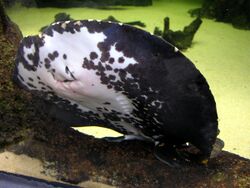Biology:Bigtooth river stingray
| Bigtooth river stingray | |
|---|---|

| |

| |
| Showing upperparts (photo above) and underparts with mouth (photo below) | |
| Scientific classification | |
| Domain: | Eukaryota |
| Kingdom: | Animalia |
| Phylum: | Chordata |
| Class: | Chondrichthyes |
| Subclass: | Elasmobranchii |
| Superorder: | Batoidea |
| Order: | Myliobatiformes |
| Family: | Potamotrygonidae |
| Genus: | Potamotrygon |
| Species: | P. henlei
|
| Binomial name | |
| Potamotrygon henlei (Castelnau, 1855)
| |
| Synonyms | |
|
Trygon henlei Castelnau, 1855 | |
The bigtooth river stingray or Tocantins River ray (Potamotrygon henlei) is a species of freshwater fish in the family Potamotrygonidae.[3] It is endemic to the lower Tocantins basin and Araguaia basin in Brazil ,[4] and prefers muddy bottoms.[1] It is sometimes kept in aquaria.[1] This stingray is generally common and its population increased after the Tucuruí Dam was completed, unlike many other species in its range.[1]
Appearance and relatives
P. henlei reaches up to 71 cm (2.33 ft) in disc width and 104.2 cm (3.42 ft) in total length.[1] It is replaced by the closely related P. rex in the mid and upper Tocantins basin, but that species has concentrically clustered yellow-orange spots.[4] Two other close relatives where the spots are yellowish-white (as in P. henlei) are found in other Brazilian rivers: P. leopoldi from the Xingu River basin and P. albimaculata from the Tapajós River basin.[5] Compared to P. leopoldi, P. henlei is duller above, appearing blackish or dark gray-brown (as opposed to deeper black in P. leopoldi), and its underparts have a large white center and broad brownish-dusky edges (underparts mostly brownish-dusky in P. leopoldi).[5][6] Compared to P. albimaculata, P. henlei has larger yellowish-white spots above.[5][6]
British Scientist and Angler , Jeremy Wade[7] once hauled out a Bigtooth River Ray from a boat , The Stingray had a black body with yellow isolated spots around the disc. Brown blotched specimens of P. Henlei are also recorded.
References
- ↑ 1.0 1.1 1.2 1.3 1.4 Rincon, G. (SSG South America Regional Workshop, June 2003) (2004). "Potamotrygon henlei". The IUCN Red List of Threatened Species (IUCN) 2004: e.T39402A10225965. doi:10.2305/IUCN.UK.2004.RLTS.T39402A10225965.en. http://www.iucnredlist.org/details/39402/0. Retrieved 11 January 2018.
- ↑ "Appendices | CITES". https://cites.org/eng/app/appendices.php.
- ↑ Froese, Rainer and Pauly, Daniel, eds. (2017). "Potamotrygon henlei" in FishBase. February 2017 version.
- ↑ 4.0 4.1 Carvalho, M.R.d. (2016): Potamotrygon rex, a new species of Neotropical freshwater stingray (Chondrichthyes: Potamotrygonidae) from the middle and upper rio Tocantins, Brazil, closely allied to Potamotrygon henlei (Castelnau, 1855). Zootaxa, 4150 (5): 537–565.
- ↑ 5.0 5.1 5.2 Carvalho, M.R.d. (2016): Description of two extraordinary new species of freshwater stingrays of the genus Potamotrygon endemic to the rio Tapajós basin, Brazil (Chondrichthyes: Potamotrygonidae), with notes on other Tapajós stingrays. Zootaxa, 4167 (1): 1–63.
- ↑ 6.0 6.1 Ramos, H.A.C. (May 2017), Commercial species of freshwater stingrays in Brazil, Department of Sustainable Use of Biodiversity and Forests, Brazilian Institute of Environment and Renewable Natural Resources and Ministry of the Environment, pp. 1–33
- ↑ (in en) Jeremy Catches A Potentially Lethal Stingray | STINGRAY | River Monsters, https://www.youtube.com/watch?v=L0asoA9mNjI, retrieved 2023-05-27
External links
Wikidata ☰ Q2684865 entry
 |


